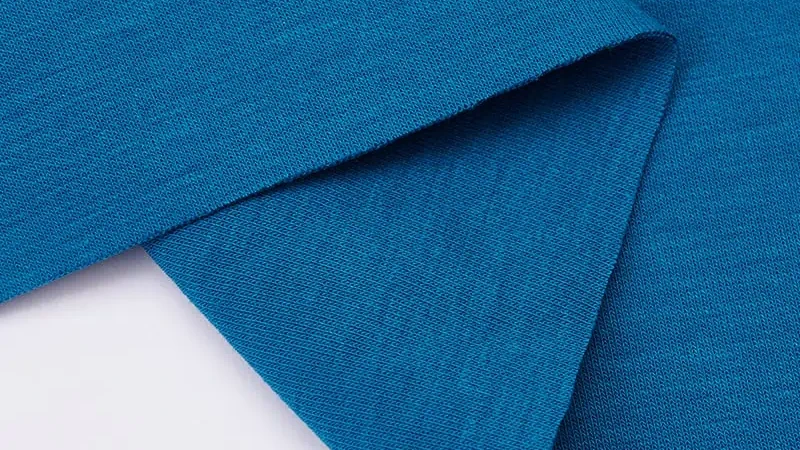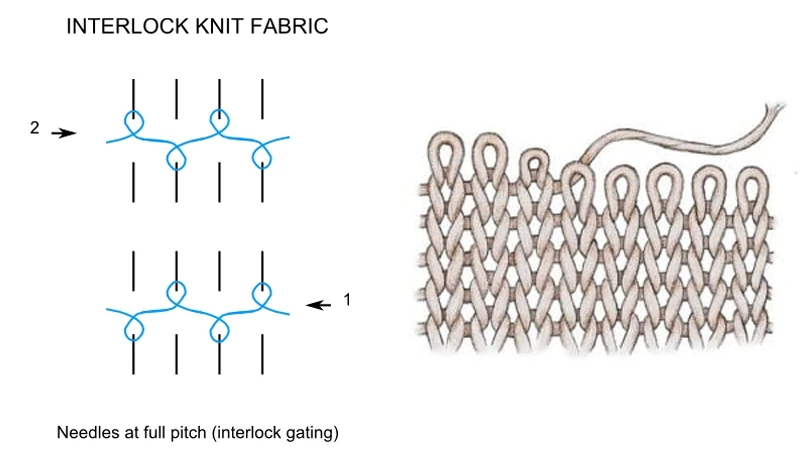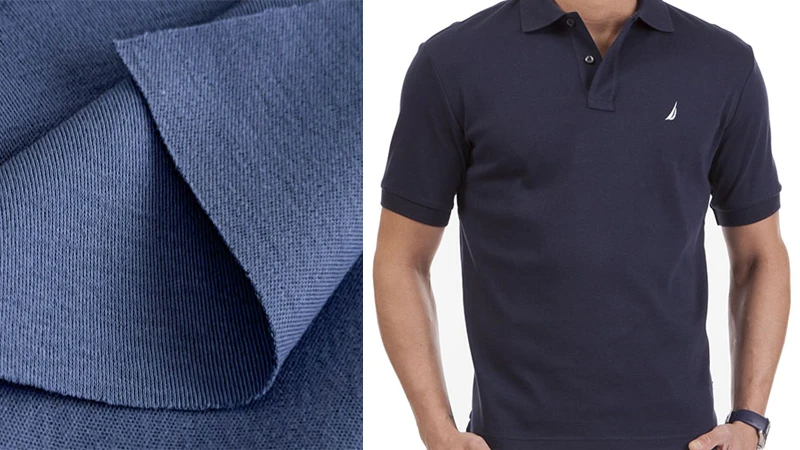Interlock fabric is a double-knit material. It feels smooth and lasts long. It is thicker than other knit fabrics. This makes it strong and usable on both sides. Interlock fabric works well for clothes and home items.
Tests show interlock fabric is important in textiles. Experts found stitch length affects heat resistance the most. Yarn heat and fabric thickness also matter. These details show why interlock fabric is useful and comfy.
If you’re new to sewing, interlock fabric is soft and simple to use. It’s great for baby clothes, daily outfits, or accessories. Interlock cotton is dependable and looks nice.
What Is Interlock Fabric?

Definition and Overview
Interlock fabric is a double-knit material with a smooth feel. Both sides look the same, making it neat and useful. It is made with two sets of needles and yarn. This process creates a thicker and stronger fabric than single-knit ones. Interlock fabric is soft, long-lasting, and can be used on either side.
Unlike other knit fabrics, interlock has a fine-knit design. Both sides match, which makes it look nice and versatile. It is like rib knit but firmer and absorbs more. These traits make it great for t-shirts, dresses, and baby clothes.
If you want a comfy and useful fabric, try interlock. It stretches well and keeps its shape better than single-knit fabrics. This helps your projects stay neat and last longer.
How Interlock Fabric Differs from Other Knit Fabrics
Interlock fabric is different from other knit fabrics in key ways. Its double-knit design makes it thicker and heavier than single-knit fabrics like jersey. This thickness adds strength and makes it last longer. It also holds its shape after washing, so it won’t shrink or twist.
Here are some features that make interlock special:
- Smooth Surface: Both sides have loops, giving it a polished look.
- Minimal Curling: Unlike jersey, it doesn’t curl at the edges, so it’s easier to sew.
- Reversible Design: Both sides look the same, offering more design options.
- Superior Thickness: It’s thicker, making it good for warm or durable projects.
Interlock fabric also performs well. Its tight stitches make it strong and stable. While it doesn’t let air through as much as lace, it keeps its shape and resists stretching. These features make it perfect for activewear, baby clothes, and everyday outfits.
If you’ve used single-knit fabrics before, you’ll notice interlock feels more solid and professional. It’s easy to work with, making it a favorite for beginners and experts alike.
How Is Interlock Knit Fabric Made?

The Double-Knit Construction Process
Interlock fabric is made using a special double-knit method. Two sets of needles work together to create strong stitches. These stitches make the fabric soft and flexible but also tough. This process results in a fabric that lasts a long time.
Making interlock fabric involves several steps. First, cotton or synthetic fibers are prepared. Then, knitting machines use the double-knit method to tightly connect the stitches. This keeps the fabric stable and stops it from stretching out. Quality checks happen during production to ensure the fabric is reliable. This careful process makes interlock fabric useful and versatile.
The double-knit design makes both sides of the fabric look the same. This is helpful for projects where both sides are visible. Whether you’re sewing clothes or home items, this method gives a neat and professional result.
Common Materials Used, Including Interlock Cotton
Interlock fabric can be made from different materials, but cotton is popular. Cotton interlock is soft, breathable, and gentle on the skin. It works well for baby clothes, casual outfits, and bedding. Organic cotton interlock is eco-friendly and just as comfy and durable.
Synthetic fibers like polyester or cotton-spandex blends are also used. These materials add stretch and make the fabric good for sportswear. Still, cotton interlock is loved for its natural feel and versatility.
Choose materials based on your project’s needs. Cotton interlock is great for everyday clothes because it’s comfy and strong. For activewear, stretchy blends might work better. No matter the material, interlock fabric’s design ensures it fits your needs.
Characteristics of Interlock Fabric
Softness and Smooth Texture
Interlock fabric is soft and smooth to the touch. This comes from its double-knit design, which creates an even surface. Unlike rough fabrics, interlock feels gentle on your skin. It’s great for baby clothes, t-shirts, and bedding.
The fabric’s smooth look makes it appear neat and polished. Both sides look the same, adding to its usefulness. You can use it for reversible clothes or simple dresses. Its clean finish gives your projects a professional look.
If you want a fabric that’s comfy and stylish, choose interlock cotton. Its softness makes it easy to wear, and its smoothness looks great.
Stretch and Stability
Interlock fabric stretches well but stays firm. Its double-knit design helps it stretch evenly without losing shape. This makes it perfect for clothes like activewear or fitted dresses.
Here’s a simple breakdown of how it performs:
| Test Component | Purpose | Key Measurements |
|---|---|---|
| Stretch Measurement | Measures how far the fabric can stretch | 15% stretch over 20 cm |
| Resistivity at Varying Elongation | Checks how fabric handles stress | Resistance change at 0%, 5%, 10%, 15% stretch |
| Stability Over Time | Tests how stable the fabric remains | Resistivity at 30, 60, 90 seconds |
These tests show interlock keeps its shape and doesn’t overstretch. It also bounces back after being stretched, so your clothes last longer.
Unlike single-knit fabrics, interlock doesn’t curl at the edges. This makes it easier to sew and keeps your projects looking tidy. Whether you’re new to sewing or experienced, you’ll find this fabric easy to handle.
Durability and Strength
Interlock fabric is strong and lasts a long time. Its tight stitches make it resist damage, so your items stay in good shape. This is important for baby clothes that need frequent washing or activewear that moves a lot.
Studies prove interlock fabric’s strength over time:
- It kept good bursting strength even after heavy use.
- While it lost some tensile strength, it still worked well.
- Regular care helps keep its strength and quality.
Interlock cotton is both strong and soft. High-quality cotton makes it last longer while staying breathable. This makes it a great choice for everyday clothes and home items.
If you need a fabric that’s tough but comfy, interlock is ideal. It holds up to daily use and stays nice for years.
Breathability and Comfort
How breathable a fabric is affects how comfy it feels. Interlock fabric, especially cotton ones, lets air flow well. Its double-knit design allows air to move through while staying soft. This keeps you cool and comfy, even in hot weather or while active.
The way interlock fabric is made adds to its comfort. Tight stitches make a smooth surface that feels nice on the skin. Unlike rough fabrics, interlock is gentle and soothing, perfect for sensitive skin. Whether it’s a t-shirt, dress, or baby clothes, this fabric feels good all day.
Studies show how fabric design affects breathability. Here’s a summary of findings:
| Study | Focus Area | Findings |
|---|---|---|
| Havlová (2013) | Air permeability | Looked at how woven fabric design impacts air flow. |
| Umair et al. (2016) | Fabric structure | Studied how fabric structure helps air flow and manages moisture. |
| Zhu et al. (2018) | Structural parameters | Predicted how fabric structure links to air flow in cotton fabrics. |
| Marie (2018) | Fabric properties | Checked air and water vapor flow with fabric structure. |
These studies show fabric design matters for breathability. Interlock fabric balances air flow and strength. Cotton interlock adds natural moisture-wicking, making it great for activewear, casual clothes, and bedding.
When picking fabric, think about how it feels on your skin. Interlock fabric is breathable and comfy all day. It keeps you cool and wicks away sweat, making it useful for many things.
Benefits of Interlock Fabric
Great for Sensitive Skin
Interlock cotton is perfect for people with sensitive skin. Its smooth surface feels soft and gentle all day. The double-knit design makes it less likely to irritate skin. This is why it’s great for baby clothes and comfy outfits for sensitive skin.
Research shows how materials can help sensitive skin. For example:
- A study found a cream with Bifidobacterium longum made skin less sensitive.
- Another study showed trans-4-tert-butylcyclohexanol reduced burning from capsaicin.
- Lab tests proved 4-tert-butylcyclohexanol stopped triggers causing skin irritation.
These studies show why soft fabrics like interlock cotton are important. They are breathable, gentle, and kind to your skin.
Flexible for Many Uses
Interlock fabric works for many creative projects. Both sides look the same, giving you more design choices. You can use it for t-shirts, dresses, or activewear. Its stretch makes it great for sportswear, while its softness suits casual clothes.
It’s also useful for home items like pillowcases or blankets. Its strength means it lasts even with regular use. This makes interlock fabric popular with both beginners and experts.
Simple to Sew and Care For
Interlock fabric is easy to sew, even for beginners. Its edges stay flat, so cutting and stitching are simple. The fabric stays stable, helping you make neat seams. It’s a great choice for making comfy clothes or activewear.
Taking care of interlock cotton is easy too. It keeps its shape after washing and doesn’t shrink. You can wash it often without worrying about damage. Whether sewing or cleaning, interlock fabric makes everything easier.
Common Uses of Interlock Cotton and Knit Fabrics

Activewear and Sportswear
Interlock fabric is great for activewear because it’s soft and stretchy. It feels smooth on your skin, making workouts more enjoyable. The fabric stretches easily and bounces back, keeping its shape after movement. This makes it perfect for leggings, sports tops, and fitted clothes.
Its strong design stops runs and curling edges, making it last longer. The fabric also absorbs sweat, helping you stay dry and focused. These features make interlock cotton a favorite for athletes and fitness fans.
Reports show more people want interlock fabric for sportswear. Shoppers like materials that are comfy, stretchy, and durable. Whether for gym clothes or casual sporty outfits, interlock fabric offers both style and performance.
Everyday Clothing, Like T-Shirts and Dresses
Interlock cotton is popular for everyday clothes because it’s soft and useful. T-shirts made from it feel smooth and airy, perfect for casual wear. Dresses made with interlock look neat but stay comfy all day.
Fashion trends now focus on casual yet stylish clothing. Interlock fabric meets this need by being both comfy and elegant. Its reversible sides allow creative designs, and its thickness makes it last longer. You can trust interlock cotton for clothes that look good and hold up well.
Studies show interlock fabric is becoming more common in casual wear. The rise of relaxed dress codes and athleisure has increased demand for comfy fabrics. Interlock cotton fits these trends, making it a top choice for designers and shoppers.
Baby and Children’s Clothing
Interlock cotton is ideal for baby and kids’ clothes. Its soft feel is gentle on sensitive skin, keeping little ones comfy all day. The fabric breathes well, keeping babies cool, and stretches for easy movement.
Parents like interlock fabric because it’s strong and simple to clean. It handles frequent washing without losing its softness or shape. From onesies to pajamas, interlock cotton is comfy and practical.
Studies show interlock fabric is also used for baby bedding. Its smooth surface and breathable design make it safe for blankets and crib sheets. Whether sewing for your child or making gifts, interlock cotton is a reliable choice.
Home Textiles and Accessories
Interlock fabric works great for home items and decorations. Its soft feel and strength make it perfect for things used often. You can make pillowcases, blankets, or cushion covers with it. These items feel cozy and add comfort to your home.
The double-knit design makes interlock fabric strong and long-lasting. This is why it’s good for home items that need to last. For example, table runners or placemats made with interlock stay in shape after many washes. Its thickness also gives a neat and polished look.
Interlock fabric is breathable, which is helpful for bedding. Sheets and duvet covers made from it feel cool and comfy, even on warm nights. This helps you and your family sleep better.
You can also use interlock fabric for decorations. Make stylish throw pillows or wall art with it. Both sides of the fabric look nice, giving you more design options. Whether you like bold or simple designs, interlock cotton works well.
Taking care of interlock fabric is easy. It doesn’t shrink and stays strong after many washes. This makes it a smart choice for home items that need frequent cleaning. With interlock cotton, you get both style and durability for your home.
Interlock fabric is special because of its useful features. It feels smooth, looks the same on both sides, and is tightly woven. These qualities make it strong and easy to work with. Its stable edges don’t curl, which helps with sewing. The fabric’s thickness also makes it last a long time. You can use it for activewear, baby clothes, or home items without trouble.
Here’s a simple summary of its main traits:
| Feature | What It Means |
|---|---|
| Same on both sides | Both sides look alike, making it neat and versatile. |
| Smooth and thick | The fabric feels soft and has a dense, sturdy build. |
| Limited stretch | It doesn’t stretch much, which keeps it steady and firm. |
| Thicker than jersey | It’s thicker, so it’s stronger and more durable. |
| Very stable | It holds its shape well and doesn’t twist or warp. |
| No edge curling | The edges stay flat, making sewing easier and tidier. |
| GSM Range | Weighs between 200-340 GSM, showing its quality and durability. |
If you’re just starting to sew, interlock fabric is a great option. It’s simple to handle and works for many projects. Try it out and turn your creative ideas into reality with this adaptable material.
FAQ
Why is interlock fabric good for beginners?
Interlock fabric stays flat at the edges. This makes cutting and sewing simple. Its firm design helps you sew clean seams easily. Even beginners find it easy to work with.
Can interlock fabric stretch for tight clothes?
Yes, it can! Interlock fabric stretches evenly and feels comfy. It’s great for leggings, sportswear, or fitted outfits. Its double-knit design keeps it strong and flexible.
How should you wash interlock fabric?
Wash interlock fabric gently in cold or warm water. Use mild soap to keep it soft. Dry it on low heat to avoid damage. This care keeps your fabric looking nice.
Is interlock fabric good for warm weather?
Yes, it is! Cotton interlock lets air flow and removes sweat. It keeps you cool and comfy in hot weather. Its smooth feel is perfect for summer clothes or bedding.
What can you make with interlock fabric?
Interlock fabric works for many things. Make t-shirts, dresses, baby clothes, or pillowcases. It’s soft and strong, great for casual wear or DIY projects.
